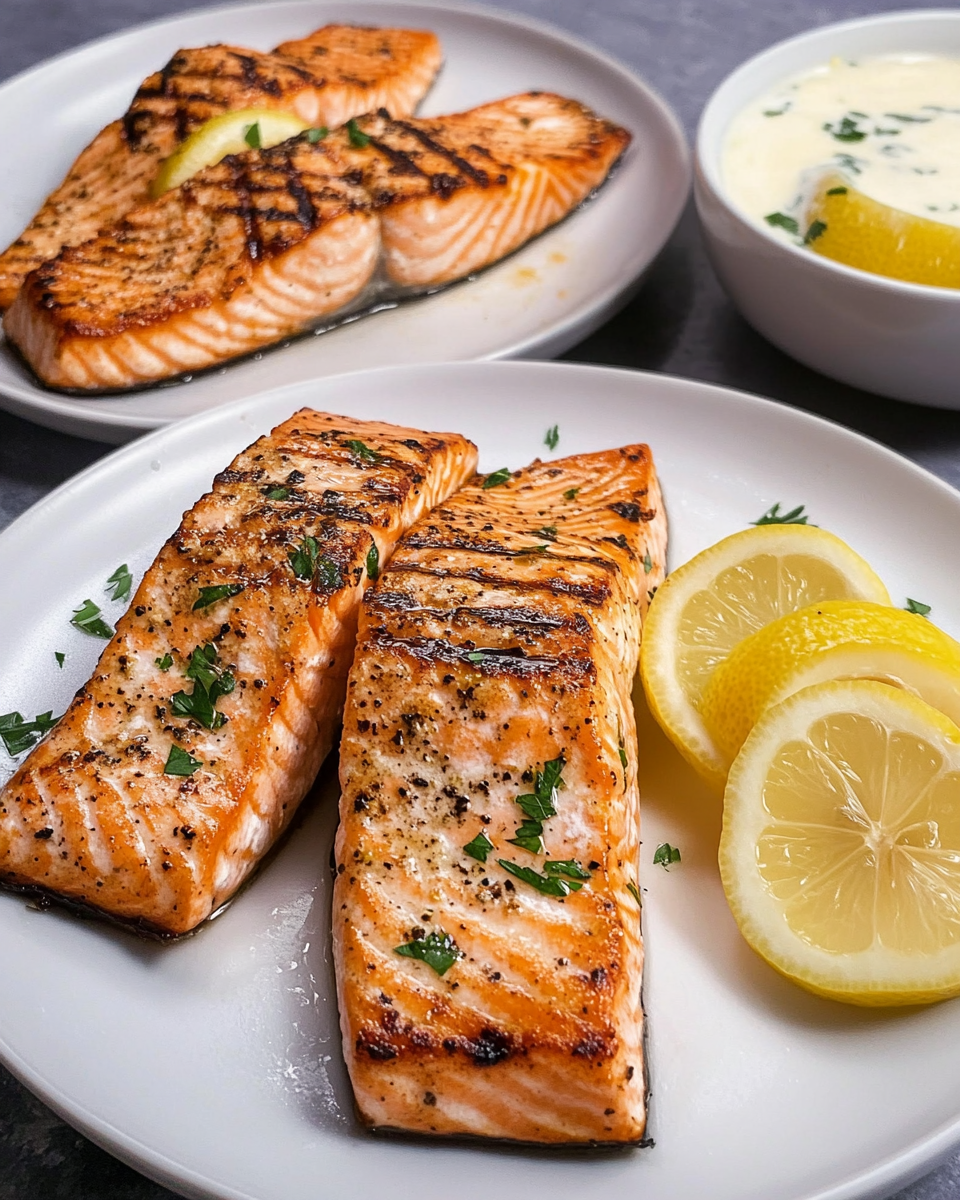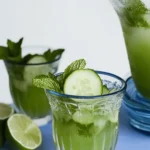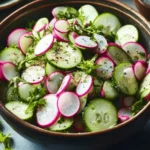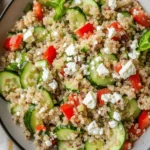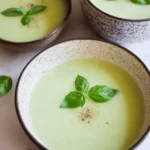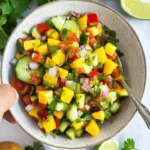This recipe offers a simple and fast way to enjoy flavorful grilled salmon fillets. Perfect for weeknight dinners or weekend cookouts, the fillets are seasoned lightly and grilled to perfection, bringing out their natural taste with a smoky char. Pair with a side salad or grilled vegetables for a complete and nutritious meal.
FULL RECIPE
Ingredients
- 4 salmon fillets (6 oz each)
- 2 tablespoons olive oil
- 1 teaspoon salt
- 1/2 teaspoon black pepper
- 1 teaspoon garlic powder
- 1/2 teaspoon paprika
- 1 tablespoon lemon juice
- Lemon wedges, for serving (optional)
Directions
- Preheat the grill to medium-high heat (about 400°F).
- Pat the salmon fillets dry with paper towels.
- In a small bowl, mix olive oil, salt, pepper, garlic powder, paprika, and lemon juice.
- Brush the mixture evenly over both sides of the salmon fillets.
- Place salmon fillets skin-side down on the grill.
- Grill for 4-5 minutes per side or until the fish flakes easily with a fork.
- Remove from grill and let rest for 2 minutes.
- Serve with lemon wedges if desired.
Nutritional Information
- Calories: 310
- Protein: 34g
- Fat: 18g
- Saturated Fat: 3g
- Carbohydrates: 1g
- Fiber: 0g
- Sugar: 0g
- Sodium: 400mg
Health Benefits of Grilled Salmon
Grilled salmon is a powerhouse of nutrition, rich in omega-3 fatty acids which are essential for heart health. These healthy fats help reduce inflammation, lower blood pressure, and may decrease the risk of heart disease. Salmon is also an excellent source of high-quality protein, important for muscle repair and maintenance. Additionally, it contains vitamin D, which supports bone health and immune function, and B vitamins that aid energy production and brain health. Including grilled salmon regularly in your diet can contribute to overall wellness.
Why Choose Grilling for Salmon
Grilling salmon imparts a smoky flavor and a slightly crispy texture that baking or pan-frying might not achieve as effectively. The high heat seals in the natural juices, keeping the fish moist and tender. Grilling is also a healthy cooking method since it requires minimal oil and allows excess fat to drip away. It is quick and efficient, making it ideal for busy weeknights or outdoor gatherings.
Selecting the Right Salmon Fillets
When choosing salmon for grilling, opt for fresh, firm fillets with a bright, moist appearance. Wild-caught salmon tends to have a richer flavor and more vibrant color, while farmed salmon is often more affordable and widely available. Skin-on fillets are preferred for grilling because the skin helps hold the fish together and prevents it from sticking to the grill.
The Role of Olive Oil in Grilling
Olive oil is used not only to add flavor but also to prevent the salmon from sticking to the grill grates. It helps create a barrier between the fish and the metal surface, reducing the chance of tearing when flipping. Olive oil also contributes healthy monounsaturated fats and antioxidants, enhancing the nutritional profile of the meal.
Importance of Seasoning
Simple seasoning with salt, pepper, garlic powder, and paprika enhances the natural taste of salmon without overpowering it. These spices bring out a subtle depth of flavor while complementing the smoky char from the grill. Lemon juice adds a bright, fresh acidity that balances the richness of the fish.
Tips for Perfect Grill Marks
Achieving attractive grill marks requires a hot grill and minimal movement of the fillets once placed. Preheating the grill ensures even cooking and helps prevent sticking. Allow the fish to cook undisturbed for several minutes before flipping to develop the characteristic sear lines and flavor.
How to Tell When Salmon is Done
Salmon is cooked perfectly when it flakes easily with a fork but still retains moisture inside. Overcooking can lead to dryness and a less appealing texture. The internal temperature should reach around 125°F to 130°F for medium doneness, which provides a tender and juicy bite.
Serving Suggestions
Grilled salmon pairs well with a variety of sides such as steamed vegetables, quinoa, rice, or fresh salads. Lemon wedges add a zesty finishing touch that brightens the flavors. For a heartier meal, consider serving with grilled potatoes or a creamy avocado salsa.
Storage and Leftover Ideas
Cooked salmon can be stored in an airtight container in the refrigerator for up to three days. Leftovers make excellent additions to salads, sandwiches, or pasta dishes. You can also flake the salmon and mix it with yogurt or mayo for a tasty spread or dip.
Sustainability Considerations
Choosing sustainably sourced salmon supports environmental conservation efforts and helps protect fish populations. Look for certifications or ask your fishmonger about the origin to ensure you’re making an eco-friendly choice.
Grilling Equipment Recommendations
Using a clean grill with well-oiled grates is essential for easy flipping and preventing sticking. A fish basket or grill mat can provide extra support for delicate fillets. A good-quality spatula with a thin edge helps lift the fish gently without breaking it apart.
Marinade Alternatives
While this recipe uses a simple olive oil and spice rub, marinating salmon in soy sauce, honey, ginger, or herbs can add exciting new flavor profiles. However, avoid overly acidic marinades for too long, as they can start to “cook” the fish and change its texture.
Seasonal Variations
In warmer months, pairing grilled salmon with fresh summer vegetables like zucchini, corn, or tomatoes highlights seasonal produce. During colder seasons, roasted root vegetables or warm grain salads provide comforting complements.
Pairing Salmon with Wine
A light white wine such as Sauvignon Blanc or Chardonnay complements the delicate flavors of grilled salmon well. For those preferring red, a Pinot Noir with its subtle tannins and fruitiness can be an excellent match.
Cultural Inspirations
Grilled salmon is enjoyed worldwide with regional variations. In Nordic countries, it might be served with dill and mustard sauces, while Japanese cuisine often features salmon with teriyaki glaze or miso marinade. Exploring these variations can inspire creative twists.
Nutritional Impact of Cooking Methods
Grilling preserves more nutrients compared to frying or boiling, which can leach vitamins and minerals. The quick cooking time also helps retain omega-3 fatty acids, making grilled salmon a nutritionally superior option.
Allergy and Dietary Considerations
Salmon is a common allergen for some people, so it’s important to be aware when serving guests. For those on low-sodium or heart-healthy diets, seasoning can be adjusted accordingly. This recipe is naturally gluten-free and fits well within paleo and keto lifestyles.
Balancing Flavors with Accompaniments
The rich, fatty nature of salmon benefits from bright and acidic accompaniments such as citrus, pickled vegetables, or fresh herbs. These elements add contrast and keep the dish from feeling too heavy.
Grilling Indoors vs Outdoors
While outdoor grilling is ideal for authentic smoky flavor, indoor grilling pans or broilers can also produce great results. Adjust cooking times and monitor heat carefully to avoid overcooking when using indoor methods.
Conclusion
Grilled salmon fillets offer a delicious and nutritious meal that is quick to prepare and versatile in flavor. The simplicity of seasoning combined with the smoky char from the grill creates a satisfying dish that supports heart health and fits various dietary preferences. Whether enjoyed with fresh salads or hearty sides, grilled salmon remains a timeless choice for both everyday dinners and special occasions. Its ease of preparation and rich nutritional benefits make it a staple worth mastering in any kitchen.

